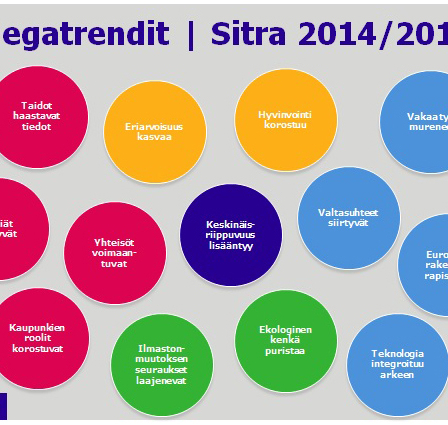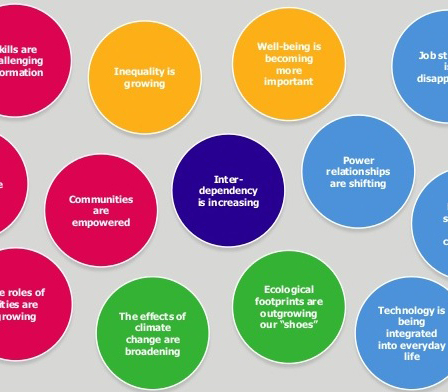Peer-to-peer networks are becoming societies’ basic structures. Hierarchical structures are substituted by networks. Why are institutions increasingly threatened while the power of individuals and communities grows? What is replacing this most basic societal structure?
It is comforting to imagine a time when communities and the institutions that served them were locked in a stable, mutually agreed relationship where needs were met with well-designed instruments. From our position in 2015, the mid-20th century appears to be a high water mark for institutions. But the relationship between individuals, communities and institutions is always changing as societies evolve. Needs and capacities are dynamic and rarely balanced. Nevertheless, coalitions have been able to form around notions of improvement, sometimes leading to the formation of new institutions that provide new services for a community. This form of institutionalisation has until now been a fairly effective means of enabling communities to gain more control over their lives.
What makes today different? Why are institutions increasingly threatened while the power of individuals and communities grows? What is replacing these most basic societal structures?
To be clear, institutions are clearly not dead. Governments, schools, public agencies and other institutions are experimenting and achieving success by empowering individuals with better participatory and co-design processes. For instance, participatory budgeting has become a widespread phenomenon, demonstrating the transformative effect of opening formerly closed processes. The City of Boston has established the United States’ first youth-led participatory budgeting process (with a one million USD budget allocation) which empowers the city’s youth to decide how the city should be improved.
However, this article will focus on community empowerment that does not originate from top-down reforms. There is an emerging spectrum of bottom-up initiatives that have empowered people to take action in many domains.
These initiatives happen largely in the absence of institutions. They are born from individuals who recognise a need or opportunity and, through their actions, set an example for how things could be done differently. For these forerunners, institutions often stand in the way of progress towards their vision of an alternate future. Their initiatives are not efforts towards reform, but are designed to operate independently of and in some cases in contradiction to norms and regulations. They begin by asking new questions for which the answers were assumed or appeared self-evident.
It is the rise of peer-to-peer networks that enables individual initiatives to scale and achieve impact in ways previously thought unimaginable. Communication technologies have eased knowledge sharing, co-creation and convening while reducing the cost of these transactions to nearly nothing. The central mechanical challenges of community empowerment such as creating collective capacity to lead change, building coalitions and resource acquisition are significantly reduced. The result is that individuals can challenge society’s central structures with alternative models. For instance, the sharing economy, while unlikely to displace capitalism, does enable people to bypass it in certain circumstances.
At one end of the community empowerment spectrum, Finland’s Ravintolapäivä (restaurant day) began with the notion that street food is an important part of city life and is a shortcut to building community. At the other end, Uber and AirBnB have grown from ideas about providing services differently into some of the world’s most valuable companies.
Ravintolapäivä’s origins stem from three friends sitting in a bar reflecting on how food makes some cities great urban experiences and contributes significantly to vibrant communities. In Helsinki, city laws pertaining to restaurants and street food constrained experimentation and informality in the name of hygiene and safety. From an institutional perspective, the safety and security of the city’s citizens is paramount and easily justifies limiting how and where food could be sold. The city administration was doing what it was designed to do: administer.
Yet for the three friends, this appeared as a roadblock to creating the kind of community they wanted to live in. Rather than officially petition the city to change its laws, they tried an experiment by reaching out through their networks to encourage anyone who wanted to set up a one-day restaurant to do so. The enabler was a simple bit of technology that connected consumers to pop-ups. On the first restaurant day in 2011, 45 restaurants were set up. To date, over 17,000 one-day restaurants have been set up in 70 countries.
Key to the Ravintolapäivä experiment was starting at a scale that could be ignored by the authorities and with violations that could go unprosecuted because of their extremely short duration (especially in the context of establishing businesses). What the first Ravintolapäivä demonstrated for the citizens of Helsinki was that the city belonged to them. They were empowered to take initiative and thereby change the city to better reflect their notions of community.
This has since led to new initiatives in Helsinki such as Siivouspäivä (a “cleaning day” where the city turns into a massive flea market), Hätäkahvit (“emergency coffee”, which allows mothers who do not know each other to reach out and meet for coffee and company and support), and Kallio-liike (“Kallio movement” which organises events, big and small, for the Kallio neighbourhood).
Ravintolapäivä has now provoked permanent changes to the city’s regulatory structure, enabling greater entrepreneurship. Food trucks, for long a staple in the US and elsewhere, are now permitted to operate in Helsinki for the first time. And around 20 new businesses can trace their origins to this experiment that helps citizens build a better city with food.
In the case of Ravintolapäivä, innovative local solutions for a trivial problem (a lack of good street food) have helped to address the larger intractable problem of stimulating entrepreneurship. From the most optimistic perspective, it has helped individuals to recognise that in order to prosper, they must individually contribute to the well-being of a larger system of which they are a part, rather than rely solely on institutional leadership.
It has also demonstrated people’s desire for communality even as notions of community seem increasingly atomised. Perhaps this is indicative of a societal shift from collectivism to collectivity. It is not that people do not want to be together, they just want to be able to do it in a new way. The decline of community associations (see Bowling Alone by Robert Putnam) and the rise of initiatives like Ravintolapäivä suggest that individuals want to maintain their distinct world view (and avoid subscribing to an ideology, however mild) while engaging in a diverse movement in which they have ownership.
Uber and AirBnB both represent a different kind of bottom-up empowerment. Each has a “wouldn’t it be cool if…” story behind its origin, similar to Ravintolapäivä. However their central conceit is to take a customer experience that was otherwise too unpleasant or inefficient and utilise technology to make it easy, individualised and fun. In the process they have created a market where transactions feel personal (and maybe empowering for the individual consumer and service provider), in part because individuals are able to circumvent traditional institutions and choose services that are better matched to their needs.
Each company can profoundly affect the economic and working lives of the taxi drivers and home owners that provide the companies’ core services. From the perspective of this article, their principle strength is to provide economic empowerment. But they are not necessarily building new communities in the process.
Now, both companies are among the most highly capitalised in the world and are driving institutional change. Most of the debate centres around taxation, but the more profound effect may be to force governments to be more responsive to their citizens. Previously unmovable organisations such as cities’ liveries are now under threat of change, and because they are traditionally highly regulated so must the regulatory structures change. With luck, these changes will lead to greater community empowerment.
In between Ravintolapäivä and Uber are variations such as Community Supported Agriculture, which enables people to become “shareholders” in a farm and help to make its operational costs more stable and therefore more sustainable. A small NGO in Helsinki called Yhteismaa (“Common Ground”) is creating platforms for people-initiated communal events such as their Home Theatre Festival that brings plays by professional actors to people’s living rooms. The enterprises on the spectrum are as diverse as the communities they serve.
This leads to a provisional definition of community empowerment: decreased distance between individuals and institutions so that power and decision-making authority shifts towards the people, enabling them to generate positive social, environmental and economic impact with local innovations.
So what role can institutions play in empowering communities (other than responsibly getting out of the way)? The can support lifelong, life-wide learning – the thread that knits together a sustainable community “production system” where individuals and community organisations have the capacity to observe needs and opportunities and develop sustainable initiatives that intervene positively.










Recommended